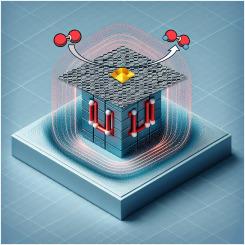Magnetic field-enhanced two-electron oxygen reduction reaction using CeMnCo nanoparticles supported on different carbonaceous matrices
IF 8.2
2区 材料科学
Q1 MATERIALS SCIENCE, MULTIDISCIPLINARY
引用次数: 0
Abstract
The current study illustrates the successful synthesis of Ce1.0Mn0.9Co0.1 nanoparticles, characterized through XRD, EPR, magnetization curves, and TEM/HRTEM/EDX analyses. These nanoparticles were then loaded into the carbon Vulcan XC72 and the carbon Printex L6 matrices in varying amounts (1, 3, 5, and 10 % w/w) via wet impregnation method to fabricate electrocatalysts for the 2-electron ORR. Before experimentation, the material was characterized via XPS and contact angle measurements. The electrochemical results produced significant findings, indicating that the electrocatalysts with the nanostructures modifying both carbon blacks notably augmented currents in rotating ring-disk electrode measurements, signifying enhanced selectivity for H2O2 production. Moreover, our research underscored the significant impact of Magnetic Field-Enhanced Electrochemistry, employing a constant magnetic field strength of 2000 Oe, on 2-electron ORR experiments. Particularly noteworthy were the observed results surpassing the ones without the magnetic field, demonstrating heightened currents and improved selectivity for H2O2 production (more than 90 %) facilitated by CeMnCo nanoparticles. These significant findings in electrocatalytic efficiency have practical implications, suggesting the potential for developing more efficient and selective catalysts for the 2-electron ORR.

使用支撑在不同碳质基质上的钴锰合金纳米粒子进行磁场增强型双电子氧还原反应
本研究成功合成了 Ce1.0Mn0.9Co0.1 纳米粒子,并通过 XRD、EPR、磁化曲线和 TEM/HRTEM/EDX 分析对其进行了表征。然后,通过湿浸渍法将这些纳米粒子以不同的用量(1%、3%、5% 和 10% w/w)添加到碳 Vulcan XC72 和碳 Printex L6 基质中,制造出双电子 ORR 的电催化剂。实验前,通过 XPS 和接触角测量对材料进行了表征。电化学结果表明,在旋转环盘电极测量中,对两种碳黑都进行了纳米结构修饰的电催化剂电流明显增大,这表明 H2O2 生成的选择性增强。此外,我们的研究还强调了磁场增强电化学(采用 2000 Oe 的恒定磁场强度)对双电子 ORR 实验的重要影响。尤其值得注意的是,观察到的结果超过了没有磁场的结果,表明 CeMnCo 纳米粒子促进了电流的增加和 H2O2 生成选择性的提高(超过 90%)。这些关于电催化效率的重要发现具有实际意义,表明有可能为 2 电子 ORR 开发出更高效、更具选择性的催化剂。
本文章由计算机程序翻译,如有差异,请以英文原文为准。
求助全文
约1分钟内获得全文
求助全文
来源期刊

Materials Today Nano
Multiple-
CiteScore
11.30
自引率
3.90%
发文量
130
审稿时长
31 days
期刊介绍:
Materials Today Nano is a multidisciplinary journal dedicated to nanoscience and nanotechnology. The journal aims to showcase the latest advances in nanoscience and provide a platform for discussing new concepts and applications. With rigorous peer review, rapid decisions, and high visibility, Materials Today Nano offers authors the opportunity to publish comprehensive articles, short communications, and reviews on a wide range of topics in nanoscience. The editors welcome comprehensive articles, short communications and reviews on topics including but not limited to:
Nanoscale synthesis and assembly
Nanoscale characterization
Nanoscale fabrication
Nanoelectronics and molecular electronics
Nanomedicine
Nanomechanics
Nanosensors
Nanophotonics
Nanocomposites
 求助内容:
求助内容: 应助结果提醒方式:
应助结果提醒方式:


